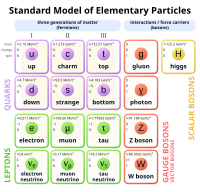
Photo from wikipedia
The hadron-quark phase transition in quantum chromodynamics has been suggested as an alternative explosion mechanism for core-collapse supernovae. We study the impact of three different hadron-quark equations of state (EoS) with… Click to show full abstract
The hadron-quark phase transition in quantum chromodynamics has been suggested as an alternative explosion mechanism for core-collapse supernovae. We study the impact of three different hadron-quark equations of state (EoS) with first-order (DD2F_SF, STOS-B145) and second-order (CMF) phase transitions on supernova dynamics by performing 97 simulations for solar- and zero-metallicity progenitors in the range of [Formula: see text]. We find explosions only for two low-compactness models (14 and [Formula: see text]) with the DD2F_SF EoS, both with low explosion energies of [Formula: see text]. These weak explosions are characterized by a neutrino signal with several minibursts in the explosion phase due to complex reverse shock dynamics, in addition to the typical second neutrino burst for phase-transition-driven explosions. The nucleosynthesis shows significant overproduction of nuclei such as 90Zr for the [Formula: see text] zero-metallicity model and 94Zr for the [Formula: see text] solar-metallicity model, but the overproduction factors are not large enough to place constraints on the occurrence of such explosions. Several other low-compactness models using the DD2F_SF EoS and two high-compactness models using the STOS EoS end up as failed explosions and emit a second neutrino burst. For the CMF EoS, the phase transition never leads to a second bounce and explosion. For all three EoS, inverted convection occurs deep in the core of the protocompact star due to anomalous behaviour of thermodynamic derivatives in the mixed phase, which heats the core to entropies up to 4k B/baryon and may have a distinctive gravitational-wave signature, also for a second-order phase transition.
Journal Title: Monthly notices of the Royal Astronomical Society
Year Published: 2022
Link to full text (if available)
Share on Social Media: Sign Up to like & get
recommendations!